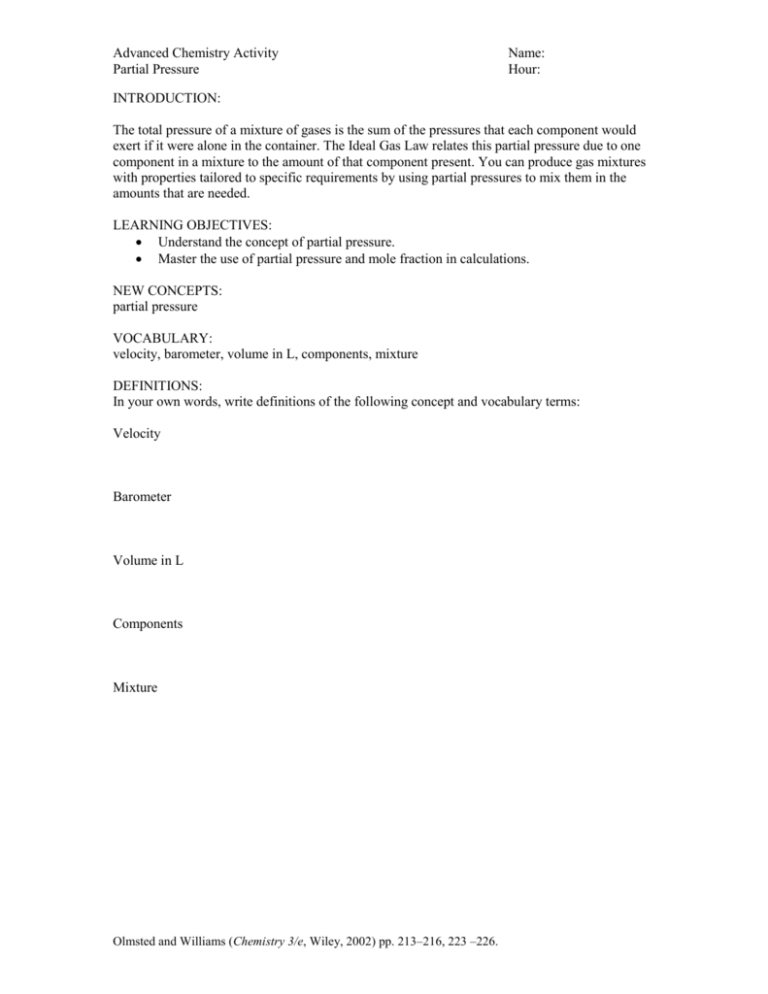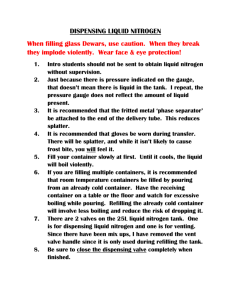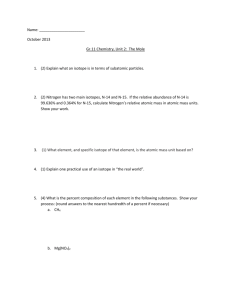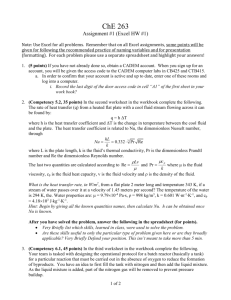INTRODUCTION:
advertisement

Advanced Chemistry Activity Partial Pressure Name: Hour: INTRODUCTION: The total pressure of a mixture of gases is the sum of the pressures that each component would exert if it were alone in the container. The Ideal Gas Law relates this partial pressure due to one component in a mixture to the amount of that component present. You can produce gas mixtures with properties tailored to specific requirements by using partial pressures to mix them in the amounts that are needed. LEARNING OBJECTIVES: Understand the concept of partial pressure. Master the use of partial pressure and mole fraction in calculations. NEW CONCEPTS: partial pressure VOCABULARY: velocity, barometer, volume in L, components, mixture DEFINITIONS: In your own words, write definitions of the following concept and vocabulary terms: Velocity Barometer Volume in L Components Mixture Olmsted and Williams (Chemistry 3/e, Wiley, 2002) pp. 213–216, 223 –226. Advanced Chemistry Activity Partial Pressure Name: Hour: MODEL AND DISCUSSION: Gases Exert Pressure Independently Condition Pressure Volume Temperature initial 1.0 atm 22.4 L 273 K final 3.0 atm 22.4 L 273 K Comment 1 mole of N2 gas fills the tank. 2 moles of O2 gas have been added to the 1 mole of N2 gas in the tank. The pressure of a gas in a sealed tank or container is caused by molecules hitting the walls of the tank and depends upon the kinetic energy of the molecules. Since the kinetic energy increases with increasing temperature, the pressure of a gas increases with increasing temperature. KEY QUESTIONS: 1. What was the initial pressure caused by the nitrogen in the tank? 2. After oxygen was added to the tank, do you think the pressure produced by the nitrogen molecules hitting the tank changed? Explain your reasoning. 3. What partial pressure do you think the nitrogen contributed to the final total pressure? Explain your reasoning. 4. If the sum of the partial pressures must equal the total pressure, what is the oxygen partial pressure in the model? 5. What fraction of the pressure (N2 partial pressure/total pressure) is due to nitrogen? 6. What is the nitrogen mole fraction (moles of N2/total moles) in the tank? 7. What is the relationship between the nitrogen pressure ratio (N2 partial pressure/total pressure) in key question 5 and the nitrogen mole fraction in key question 6? Express this relationship in the form of an equation. 8. What is a situation in your everyday life where you encounter a mixture of gases? Olmsted and Williams (Chemistry 3/e, Wiley, 2002) pp. 213–216, 223 –226. Advanced Chemistry Activity Partial Pressure Name: Hour: EXERCISES: 1. The mole fraction of oxygen in air is 0.209. Assuming nitrogen is the only other constituent, what are the partial pressures of oxygen and nitrogen when the barometer reads 755 torr? 2. Calculate the partial pressure of 2.25 moles of oxygen that have been mixed (no reaction) with 1.75 mole of nitrogen in a 15.0 L container at 298. K. PROBLEMS: 1. A 25.0 L gas cylinder at 32°C is filled with 2.33 moles of carbon dioxide and 4.66 moles of nitrogen. Calculate the total pressure and the mole fractions and partial pressures of carbon dioxide and nitrogen in the cylinder. 2. Mixtures of helium and oxygen are used in scuba diving tanks to help prevent the bends, which is a condition caused by nitrogen bubbles forming in the bloodstream. If 95 L of oxygen and 25 L of helium at STP are pumped into a scuba tank with a volume of 8.0 L, what is the partial pressure of each gas in the tank and what is the total pressure in the tank at 25°C? 3. Oxygen gas generated by the decomposition of potassium chlorate is collected over water at 25°C in a 1.00 L flask at a total pressure of 755.3 torr. The vapor pressure of water at 25°C is 23.8 torr. How many moles of KClO3 were consumed in the reaction? 2 KClO3(s) 2KCl(s) + 3O2(g) Olmsted and Williams (Chemistry 3/e, Wiley, 2002) pp. 213–216, 223 –226.







